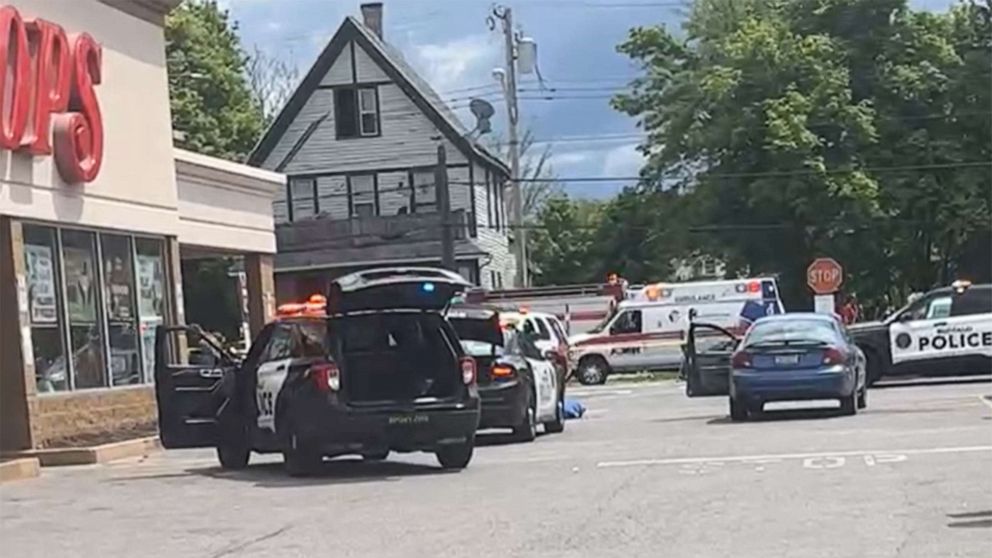


Law enforcement officials say the Buffalo, New York, supermarket shooting has underscored their long-held fear that someone could be radicalized online, have access to guns, take inspiration from prior attacks and then carry out an act of murderous violence against a soft target, like a grocery store.
Ten people -- all of whom were Black -- were killed in Saturday's mass shooting in Buffalo in a rampage authorities are calling a "racially-motivated hate crime."
The 180-page document believed to have been written by the Buffalo suspect, 18-year-old Payton Gendron, includes praise for the 2015 mass shooting at a Charleston, South Carolina, church where nine Black parishioners were gunned down.
Evidence points to the Buffalo shooting being a calculated, racially-motivated execution by a teenager who appeared to have been targeting Black people, according to multiple sources and a review of FBI cases and testimony. The hate-filled document apparently written by Gendron includes the radical notion that white people are being replaced in the U.S.
The teen gunman allegedly wanted a race war and livestreamed the attack in an apparent effort to spur others to kill minorities, sources said.
Law enforcement has had mounting concerns about so-called lone wolf killers -- and white supremacists have been chief among them, sources said.
The FBI has warned that this trend has been increasing in violence: the 2015 Charleston church massacre targeting Black parishioners claimed nine lives; the 2018 mass shooting at a Pittsburgh synagogue killed 11 people; and the 2019 mass shooting at an El Paso Walmart, targeting Hispanics, took 23 lives.
MORE: At least 10 dead in mass shooting at Buffalo, New York, supermarket in alleged hate crimeAccording to the FBI, domestic extremists -- many of them racially motivated -- have killed more people in the U.S. than any other group since 9/11, including internationally-inspired terrorists.
"Over the last several years the U.S. has experienced a sustained level of violence by individuals who self-connect with extremist causes -- primarily through the consumption of online content -- and who, independent of a terrorist or extremist organization, will go out and engage in mass casualty, violent attacks," said ABC News contributor John Cohen, a former top official in the Department of Homeland Security.
Cohen noted several conditions that have converged to create this dangerous environment: the polarization of discourse in the U.S. where some people view those who disagree with them as the enemy; public figures mimicking violent extremists' words; and an online ecosystem "saturated with conspiracy theories and other information" published with "the intention of sowing discord and inspiring violence."
MORE: Dallas shooting may be linked to attack on Asian businesses"Those are the conditions that have all come together to make ... the most volatile, complex and dynamic threat environment I've experienced in 38 years," Cohen warned. "It's those dynamics that have law enforcement very concerned that this is a trend that not only will continue, but get worse."
There's also the pandemic factor. A bulletin from Orange County, California, authorities last year highlighted the impressionable nature of young people who've been largely isolated during the pandemic and are "radicalized online by racially motivated violent extremist propaganda."
MORE: Milwaukee mayor announces 2-night curfew after mass shootingsIn Gendron's document, he claimed he settled on his beliefs through what he found on the internet and that there was little to no influence on his beliefs by people he knew in person. The person Gendron said radicalized him the most was the gunman who attacked two mosques in New Zealand in 2019, killing 51 people.
Gendron has been arraigned on one count of first-degree murder and is due back in court on May 19.
As the investigation continues, Sunday worshippers at predominantly Black churches in New York City can expect to see additional police patrols. The shooting caused police to move resources to Black churches "to provide a visible presence in the event of any copycat but moreover to provide an air of protection and safety who go to the larger houses of worship," the NYPD said.
The NYPD said there is no known threat to New York and described the shift of resources as a precaution.
ABC News' Jack Date, Alex Mallin and Quinn Owen contributed to this report.